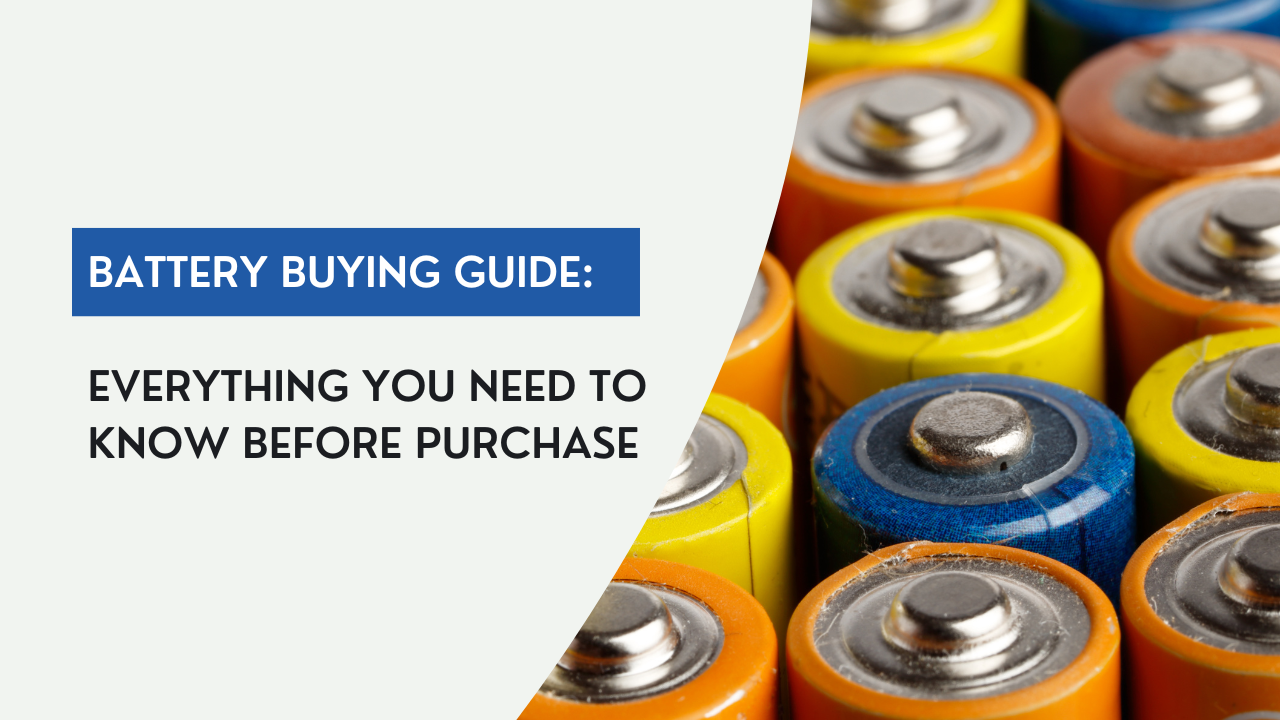
Battery Buying Guide: Everything You Need to Know Before Purchase
Choosing the perfect battery is not as easy as it sounds. There are plenty of factors that you need to take into consideration, such as why you need them, their environmental impact, and the price. However, the perfect battery will give you a balance of long duration, high performance, fair cost, and low environmental impact.
Whether you're replacing a car battery, shopping for AA cells for your gadgets, or choosing a battery backup system, picking the right battery is essential for performance, safety, and value. In this battery buying guide, we will walk you through the most important aspects that you need to make sure of before purchasing a battery.
1-Understanding Your Device
The first step in selecting the right battery is understanding your device or system. You need to determine the application you need to power, whether it is household electronics (remotes, toys, flashlights), automotive (cars and motorcycles), portable devices (phones, cameras, laptops), or even for a solar storage system. Determining the application matters in terms of the required battery size, type, and voltage.
2-Battery Type
When it comes to battery types, there are a lot to choose from. Each type has different characteristics and serves different purposes. Here is a detailed explanation for some common types:
-
Alkaline Batteries
Alkaline batteries are the most common single-use batteries. They use zinc and manganese dioxide chemistry, delivering 1.5 volts per cell. While perfect for devices that need minimal power over long periods, they’re not economical for heavy or frequent use. This kind of battery is more suitable for remote controls, clocks, flashlights, and toys.
Alkaline batteries are known for their affordability, reliability for low-drain applications, and long shelf life (up to 10 years). On the other hand, they are not rechargeable and have low performance in high-drain devices.
-
Lithium-Ion Batteries
When it comes to modern portable electronics and EVs, Li-ion batteries are the go-to choice. Their compact size and powerful output make them ideal for high-performance devices. However, they require careful handling and certified brands due to safety risks. This battery type is suitable for smartphones, laptops, drones, power banks, and electric vehicles.
-
Lead-Acid Batteries
Lead-acid batteries have been around for over a century. Despite their weight and environmental impact, they remain a go-to for automotive and backup power applications due to their low cost and high surge capability. This battery is known for cost-effectiveness, as well as its high performance in cold weather, and is reliable and robust for large-scale energy needs. However, it is heavy and bulky, and it contains toxic materials (must be recycled properly).
-
Nickel-Metal Hydride Batteries
NiMH batteries are a solid alternative to disposable AA and AAA batteries. They offer a balance between affordability, safety, and performance. Best used in medium-drain household electronics that get regular use. They are usually used for rechargeable AA/AAA batteries for remotes, wireless keyboards, and cameras.
3-Voltage Compatibility
Basically, voltage is the electrical potential a battery provides to push current through a circuit. Think of it as the “pressure” in a water pipe: more pressure equals more push.
It is important to know that every electronic device is designed to operate at a specific voltage range. Supplying too little voltage can cause the device to underperform or not work at all. Supplying too much voltage can damage the electronics or cause overheating.
There are two reasons for knowing the voltage compatibility: the first is to match the required voltage, as you always need to check the device’s specifications or battery compartment for the required voltage. For instance, if it says 1.5V, don’t use a 3.7V cell as it will likely damage the circuit. The second reason is not to mix batteries of different voltages, even if they are the same size.
4-Recarghable or Single-use
If you are wondering whether you should get rechargeable or single-use batteries, that depends on the device you aim to power. However, there are advantages and disadvantages for both types.
-
Rechargeable Batteries
- Pros: More eco-friendly with little environmental impact; more cost-effective over time; they offer long-term value.
- Cons: More expensive upfront cost than single-use batteries.
-
Single-use Batteries
- Pros: Cheaper than other kinds of batteries; widely available; more convenient.
- Cons: More environmental impact.
5-Cost and Value
This is a very essential aspect to take into consideration when purchasing a battery. It is not enough to just compare prices, but more importantly, compare the price per use. That being said, rechargeable batteries may cost more at first, but they will save you more money over time.
By considering these factors—device compatibility, battery chemistry, voltage, rechargeability, and cost—you can confidently choose the perfect battery for your needs. Always prioritize safety and proper disposal when handling batteries.
FAQs
Q1: How do I determine the voltage battery my device requires?
A1: Always check your device's specifications or inside the battery compartment for the required voltage.
Q2: Are rechargeable batteries always better than single-use ones?
A2: Not always. Rechargeables are better for frequent use and long-term cost, while single-use are cheaper upfront and more convenient for low-drain, infrequent uses.
Q3: What does "high-drain" or "low-drain" mean for batteries?
A3: High-drain devices (like digital cameras) need a lot of power quickly. Low-drain devices (like clocks) use very little power over a long time.
Q4: Should I recycle all my used batteries?
A4: Yes, always recycle batteries properly to minimize environmental impact, especially those containing toxic materials like lead-acid and NiCd.

